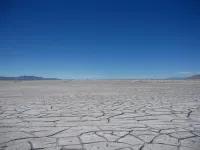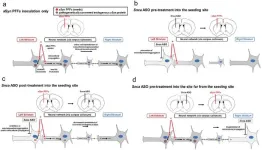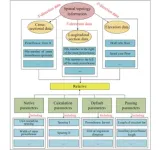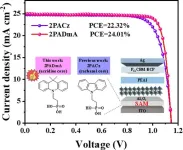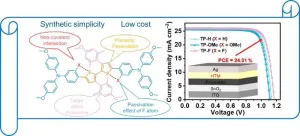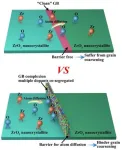(Press-News.org) Newly announced research by Royal Ontario Museum (ROM) examining greenhouse gas emissions from the drying lake bed of Great Salt Lake, Utah, calculates that 4.1 million tons of carbon dioxide and other greenhouse gases were released in 2020. This research suggests that drying lake beds are an overlooked but potentially significant source of greenhouse gases, which may further increase due to climate change. These results were announced in the paper, “A desiccating saline lake bed is a significant source of anthropogenic greenhouse gas emissions,” published in the journal One Earth.
“Human-caused desiccation of Great Salt Lake is exposing huge areas of lake bed and releasing massive quantities of greenhouse gases into the atmosphere,” said Soren Brothers, who led this research and is ROM’s Allan and Helaine Shiff Curator of Climate Change. “The significance of lake desiccation as a driver of climate change needs to be addressed in greater detail and considered in climate change mitigation and watershed planning.”
From year to year, Great Salt Lake’s water level varies, largely depending on the volume of meltwater that flows into the lake from the surrounding mountains — from record highs in the 1980s to a record low in 2022. However, it is human-related consumption by agriculture, industry, and municipal uses, that consume ever-increasing amounts of freshwater that, over the years, has depleted the lake. Elsewhere around the world, these same competing uses for water are having a significant impact on lake levels. As iconic saline lakes such as the Aral Sea, Lake Urmia, the Caspian Sea, and Great Salt Lake dry up, they not only destroy critical habitat for biodiversity and create air quality conditions that deteriorate human health, but they also accelerate climate change as newly exposed sediments emit carbon dioxide and methane.
The research team measured carbon dioxide and methane emissions from the exposed sediments of Great Salt Lake, Utah, from April to November 2020, and compared them with aquatic emissions estimates to determine the anthropogenic greenhouse gas emissions associated with desiccation. Calculations based on this sampling indicate the lake bed emitted 4.1 million tons of greenhouse gases to the atmosphere, primarily (94%) as carbon dioxide, constituting an approximately 7% increase to Utah’s human-caused greenhouse gas emissions.
Fieldwork was conducted while Soren Brothers was Assistant Professor of Limnology at Utah State University, and lead author, Melissa Cobo, was a master’s student at USU. Co-author Tobias Goldhammer is a collaborating researcher at the Leibniz Institute for Freshwater Research (IGB Institute) in Berlin, Germany. Measurements of carbon dioxide and methane gases were made every two weeks from the dried-up lake bed using a portable greenhouse gas analyzer attached to a closed chamber. Seven sites at one location at the south end of the lake were visited repeatedly over the course of the year, and another three locations were sampled during an intensive three-day campaign to determine spatial variability across the lake, which at 1,700 square miles (4,400 square kilometres) is the largest saline lake in the western hemisphere. As methane is 28 times more powerful a greenhouse gas than carbon dioxide, the global warming impact of these emissions was calculated as “carbon dioxide equivalents” to account for the greater impact of methane. Ultimately, these data indicated that greenhouse gas emissions from the dried lake bed were strongly and positively related to warm temperatures, even at sites that have been exposed for over two decades. To determine whether the lake historically would have been a significant source of greenhouse gases, the team carried out measurements of near-shore greenhouse gas emissions from the lake, as well as analyzing water chemistry collected by the team and government data sets. Together, these analyses showed that the original lake was not likely a significant source of greenhouse gases to the atmosphere, making the dried-up lake bed a novel driver of atmospheric warming.
As climate change exacerbates drought in arid regions, desiccation of rivers and lakes may be contributing to climate change feedback loops and should be considered in assessments of global greenhouse gas output as well as reduction policies and efforts.
END
Royal Ontario Museum scientist identifies Great Salt Lake as a significant source of greenhouse gas emissions
Desiccating salt lakes identified as underappreciated sources contributing to climate change
2024-07-25
ELSE PRESS RELEASES FROM THIS DATE:
Provision of stroke care services by community disadvantage status
2024-07-25
About The Study: Hospitals in communities with the greatest level of socioeconomic disadvantage had the lowest likelihood of becoming stroke certified while hospitals in the most advantaged communities had the highest likelihood in this cohort study. These findings suggest that there is a need to support hospitals in disadvantaged communities to obtain stroke certification as a way to reduce stroke disparities.
Corresponding Author: To contact the corresponding author, Renee Y. Hsia, M.D., M.Sc., email renee.hsia@ucsf.edu.
To access the embargoed study: Visit our For The Media website at this link ...
Bilateral mastectomy and breast cancer mortality
2024-07-25
About The Study: This cohort study indicates that the risk of dying of breast cancer increases substantially after experiencing a contralateral breast cancer. Women with breast cancer treated with bilateral mastectomy had a greatly diminished risk of contralateral breast cancer; however, they experienced similar mortality rates as patients treated with lumpectomy or unilateral mastectomy.
Corresponding Author: To contact the corresponding author, Steven A. Narod, M.D., email steven.narod@wchospital.ca.
To access the embargoed study: Visit our For The Media website at this link https://media.jamanetwork.com/
(doi:10.1001/jamaoncol.2024.2212)
Editor’s ...
Antisense oligonucleotide treatment shows promise in treating Parkinson's disease progression
2024-07-25
TMDU researchers demonstrate proof of concept of antisense nucleic acid therapy to prevent the spread of α-synuclein pathologies in synucleinopathies.
Tokyo, Japan – Parkinson’s disease (PD), as well as many other neurodegenerative disorders, has shown a link between the abnormal aggregation of a protein called α-synuclein (aSyn) and neuronal death. These aggregates, known as Lewy bodies and Lewy neurites depending on their subcellular localization, can spread by continuously causing normal endogenous aSyn to misfold. The complex nature of this aggregation process poses significant challenges ...
Intelligent engineering: AI transforms spatial arrangement of hydropower underground facilities
2024-07-25
Designing the spatial arrangement of underground powerhouses involves numerous complex parameters and boundaries, requiring frequent reference to various cases and specifications. Traditional methods struggle to efficiently retrieve this information, leading to suboptimal designs and extended project timelines. Due to these challenges, there is a pressing need for a more intelligent and efficient approach to streamline the design process, enhance accuracy, and improve project management in hydropower engineering.
Researchers from Tianjin University, in collaboration with PowerChina Kunming Engineering Corporation Limited and other ...
Unlocking new potential in solar tech: dimethyl acridine enhances perovskite solar cells
2024-07-25
Perovskite solar cells (PSCs) are highly regarded for their exceptional performance and straightforward fabrication. However, traditional hole transport layers (HTLs) like Poly (triarylamine) (PTAA), Nickel Oxide (NiOx), and poly (3,4-ethylenedioxythiophene)-poly (styrenesulfonate) (PEDOT) have inherent limitations that impede efficiency and stability. These materials often suffer from issues such as hydrophobicity, high reactivity, and acidity, which negatively affect the overall performance of PSCs. Due to these challenges, there is a pressing ...
Harnessing blue energy: advanced nanofluidic membranes boost aquatic energy conversion efficiency
2024-07-25
To achieve carbon neutrality, advancements in energy conversion and storage technologies are essential. Current aqueous energy devices suffer from performance limitations due to the trade-off between permeability and selectivity in permselective membranes. This trade-off hampers the efficiency of energy conversion and storage systems, necessitating the development of membranes that can balance these properties effectively. Due to these challenges, further research is required to explore innovative membrane structures that can enhance the performance of energy conversion and storage devices.
A research team from Tsinghua University has published a study (DOI: 10.26599/EMD.2024.9370041) ...
Unlocking solar efficiency: a leap in perovskite solar cell technology
2024-07-25
Perovskite solar cells (PSCs) are celebrated for their exceptional photovoltaic performance and affordability. However, the high cost of charge transport materials remains a major obstacle to their commercialization. Conventional materials like 2,2',7,7'-Tetrakis[N,N-di(4-methoxyphenyl)amino]-9,9'-spirobifluorene (Spiro-OMeTAD), are expensive and complex to produce. Therefore, developing low-cost, efficient alternatives is essential to make PSCs more economically viable. Addressing these issues is crucial for advancing solar technology and achieving broader adoption. Hence, this study focuses ...
An effective strategy to inhibit grain coarsening: Construction of multi-element co-segregated grain boundary complexion
2024-07-25
To date, ceramic scientists have devised various strategies to impede grain coarsening. The utilization of nano-sized precursor powder can not only facilitate the densification process, but also yields bulk ceramics with reduced grain sizes compared with micron-sized precursor powder. Rapid sintering by passes the low-temperature surface diffusion stage and directly enters the high-temperature sintering stage through rapid heating, rendering it an effective way to inhibit grain coarsening. However, these aforementioned strategies fail to prevent coarsening during the application of nano-ceramics in medium- ...
Insilico releases AI-powered hardware platform, PandaOmics Box for on-premise drug discovery and personalized medicine research
2024-07-25
The development of innovative medicines is an expensive, time-consuming and risky business. On average, it usually takes at least a decade and billions of dollars to bring a new drug from project initiation to approval. Identifying effective targets and conducting biological analysis is the first step in the process and remains a top priority in drug development.
To facilitate for maximum data privacy and data security, Insilico Medicine ("Insilico"), developed a hardware platform, PandaOmics Box, that does not require Internet access and allows for on-premise biological analytics, target identification, biomarker ...
RSNA makes strides in narrowing radiology gender gap
2024-07-25
OAK BROOK, Ill. – The radiology gender gap is decreasing, but there remains work to be done, according to an editorial published today in RadioGraphics, a journal of the Radiological Society of North America (RSNA).
In 2022, nearly half of residents and fellows in Accreditation Council for Graduate Medical Education
(ACGME)–accredited programs were female. However, less than 27% of active diagnostic radiologists and only 10% of active interventional radiologists are female. Within the 48 largest medical specialty groups, diagnostic radiology ranks 41st and ...
LAST 30 PRESS RELEASES:
Making lighter work of calculating fluid and heat flow
Normalizing blood sugar can halve heart attack risk
Lowering blood sugar cuts heart attack risk in people with prediabetes
Study links genetic variants to risk of blinding eye disease in premature infants
Non-opioid ‘pain sponge’ therapy halts cartilage degeneration and relieves chronic pain
AI can pick up cultural values by mimicking how kids learn
China’s ecological redlines offer fast track to 30 x 30 global conservation goal
Invisible indoor threats: emerging household contaminants and their growing risks to human health
Adding antibody treatment to chemo boosts outcomes for children with rare cancer
Germline pathogenic variants among women without a history of breast cancer
Tanning beds triple melanoma risk, potentially causing broad DNA damage
Unique bond identified as key to viral infection speed
Indoor tanning makes youthful skin much older on a genetic level
Mouse model sheds new light on the causes and potential solutions to human GI problems linked to muscular dystrophy
The Journal of Nuclear Medicine ahead-of-print tip sheet: December 12, 2025
Smarter tools for peering into the microscopic world
Applications open for funding to conduct research in the Kinsey Institute archives
Global measure underestimates the severity of food insecurity
Child survivors of critical illness are missing out on timely follow up care
Risk-based vs annual breast cancer screening / the WISDOM randomized clinical trial
University of Toronto launches Electric Vehicle Innovation Ontario to accelerate advanced EV technologies and build Canada’s innovation advantage
Early relapse predicts poor outcomes in aggressive blood cancer
American College of Lifestyle Medicine applauds two CMS models aligned with lifestyle medicine practice and reimbursement
Clinical trial finds cannabis use not a barrier to quitting nicotine vaping
Supplemental nutrition assistance program policies and food insecurity
Switching immune cells to “night mode” could limit damage after a heart attack, study suggests
URI-based Global RIghts Project report spotlights continued troubling trends in worldwide inhumane treatment
Neutrophils are less aggressive at night, explaining why nighttime heart attacks cause less damage than daytime events
Menopausal hormone therapy may not pose breast cancer risk for women with BRCA mutations
Mobile health tool may improve quality of life for adolescent and young adult breast cancer survivors
[Press-News.org] Royal Ontario Museum scientist identifies Great Salt Lake as a significant source of greenhouse gas emissionsDesiccating salt lakes identified as underappreciated sources contributing to climate change
